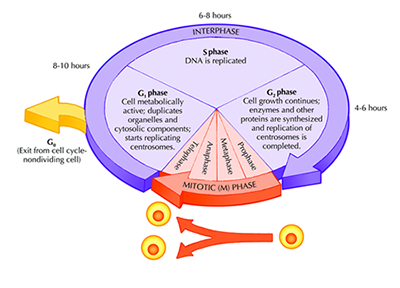Different Phases of Cell Cycle and Its Main Events within
Cell cycle, which refers to the whole process from the first split that produce new cells to the end of second division, including two stages of the interval and split. The interval can be divided into three phases: DNA synthesis (G1 phase), DNA synthesis stage (S phase) and late stage of DNA synthesis (G2 phase) 1. G1 phase. This period will vary from different cells, the majority of cells in the body will differentiate and implement their respective functions after the completion of last division. The early stage of this G1 phase is being called G0 phase, and the cells began to satisfy the needs for precursor substances, energy and enzymes of the next split synthetic DNA at the last stage of G1 phase. 2. S phase - The critical moment of the cell cycle. DNA is doubled by replicating, and the somatic cells become tetraploid, each of which is converted into two chromosomes connected by centromere. At the same time, it synthetised histones and duplicate the central particle. S phase generally takes several hours. 3. G2, is the final preparation for the division. The central particles have been completed, formatting two central body and synthesising RNA and tubulin etc. G2 period is relatively constant, usually need 1 to 1.5 hours. Split Period The metosis will need prophase, metaphase, anaphase and telophase, which is a continuous process, dividing into two sub-cells from brood cells. Generally, this period needs 1 to 2 hours. 1.Prophase, the chromatin is high degree of spiral, and gradually form a chromosome. The chromosomes are short, thick and strongly basophilic. The two central bodies move in the opposite direction, forming poles in the cells, and then synthesize the microtubules with the centrioles as the starting point to form the spindles. The nucleolus began to collapse into discrete vesicular endoplasmic reticulum. 2.Metaphase. Cells become spherical, the nucleolus and the nuclear envelope have completely disappeared. The chromosomes are moved to the equatorial plane of the cell and the microtubules emitted from the poles of the spindle are attached to the centromere of each chromosome. A total of 46 chromosomes were obtained, of which 44 were autosomes and 2 were sex chromosomes. The chromosomes were male 44 + XY and 44 + XX. The isolated chromosomes were short, , Consisting of two dyed monomers joined by narrowed centromere connections. 3.Anaphase. Due to the activity of the spindle microtubules, the centromere of the filaments, the two dyed monomers of each chromosome are separated and moved in the opposite direction, close to the respective central bodies, and the dyed monomers are divided into two groups. At the same time, Cell wave length, and because of the equatorial cell membrane under the circulation of microfilm activity, the cells were dumbbell-shaped. 4.Telophase. The chromosome was gradually re-emerged, and the endoplasmic reticulum vesicles were combined with nuclear membrane. The constriction of the equatorial plane was deepened and finally divided into two diploid somatic cells. G0 Period: temporarily leave the cell cycle, stopping cell division to perform a certain biological function of the cells in the period. According to the split ability of cells, can be divided into three main categories: A.Cell proliferation populations, such as hematopoietic stem cells, epidermis and gastrointestinal mucosal epithelial stem cells. B.No longer proliferating cell populations, such as mature red blood cells, nerve cells, cardiomyocytes and other highly differentiated cells. C. Cell populations that will not proliferating temporary, such as liver cells, kidney Tubular epithelial cells, thyroid follicular epithelial cells, which are differentiated and perform specific functional cells, are usually in the G0 phase, and are also known as G0 cells. These are the details for the different phases and main events of cell cycle. Related products: Cell cycle assays Cell Proliferation
Your email address will not be published. Required fields are marked *


This is a placeholder comment.